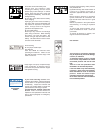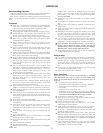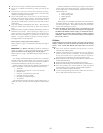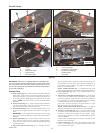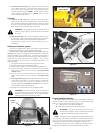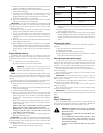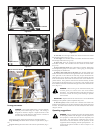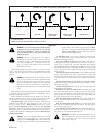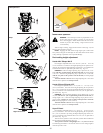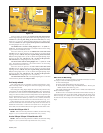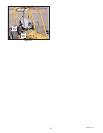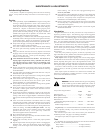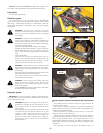
1. Before starting tractor each day, perform daily pre-operation
checking. (See Safety start interlock system section)
2. Make sure the control levers are in the park brake position and deck
clutch switch is disengaged.
3. Use choke, if unit is equipped with one, when engine is cold, or if
warm engine fails to start within 5 seconds of cranking. Avoid
flooding and operate engine without choking as soon as possible.
4. Set throttle at approximately 1/2 open position.
5. Insert key in ignition switch and rotate full clockwise to engage
starting motor. Release key when engine starts.
IMPORTANT: The engine starter should not be operated for periods
longer than 30 seconds at a time. An interval of at least two minutes should
be allowed between such cranking periods to protect the starter from
overheating and burn-out.
6. Perform test to make sure safety start interlock system is operating
properly. Refer to Safety start interlock system section.
7. As soon as engine begins to run, check to make certain the oil
warning light, check engine light and alternator warning light (if
applicable) are off. If not, stop engine immediately and check for
the cause.
8. Allow the engine to idle a few minutes before advancing the throttle
and/or engaging the deck clutch.
9. Before stopping the engine, place the control levers in the park brake
position, disengage the deck clutch, and throttle back to low idle for
a couple of minutes; then rotate ignition key counter-clockwise to
the OFF position. Remove the key from switch before leaving the
tractor.
Engine (diesel) starting
The Hustler Super Z Diesel safety start interlock system is also
designed to protect the operator and others from accidental injury due to
unintentional engine starting. The engine starting motor will not engage
until:
A. Control levers are in the park brake position.
B. Deck clutch switch is in the down (OFF) position.
WARNING: The safety interlock system must not be
disconnected or bypassed. Doing so could cause the machine
to operate unexpectedly resulting in personal injury.
NOTE: The operator’s seat is equipped with a separate safety switch.
If for any reason the operator should become unseated when the brake
switches are disengaged or the deck clutch switch is engaged the engine
will stop.
The following steps are the correct procedures for starting the engine.
If difficulty is encountered, contact the Hustler Dealer in your area.
1. Before starting tractor each day, perform daily pre-operation
checking.
2. Make sure the control levers are in the park brake position and deck
clutch switch is disengaged.
3. Set throttle at approximately 1/2 open position.
4. Insert key in ignition switch and rotate it to the ON position, then
hold the pre-heat switch down to pre-heat the engine, hold this
position for 6 seconds. This is necessary only when the temperature
is below 50
o
F. This operation is not necessary when restarting a
warm engine.
Shown in the chart are the standard preheating times for various
temperatures. This operation, however, is not required when the
engine is warmed up.
Failure to follow these recommendations can lead to premature
failure of the starter motor and the fuel shut-off solenoid.
NOTICE: Ether, or other starting fluids, must never be used as a
starting aid with this engine. Warranty will be denied when
engine damage results from such use.
5. Rotate ignition switch key full clockwise to engage starting motor.
Release key when engine starts.
IMPORTANT: The engine starter should not be operated for periods
longer than 30 seconds at a time. An interval of at least two minutes should
be allowed between such cranking periods to protect the starter from
overheating and burn-out.
6. Perform test to make sure safety start interlock system is operating
properly. Refer to Safety start interlock system section.
7. As soon as engine begins to run, check to make certain the oil
warning light is off. If not, stop engine immediately and check for
the cause.
8. Allow the engine to idle a few minutes before advancing the throttle
and/or engaging the deck clutch.
9. Before stopping the engine, place the control levers in the park brake
position, disengage the deck clutch, and throttle back to low idle for
a couple of minutes; then rotate ignition key counter-clockwise to
the OFF position. Remove the key from switch before leaving the
tractor.
Stopping the engine
Use the following procedure to shut off the engine after operating the
equipment.
1. Place the control levers in the park brake position
2. Disengage the deck clutch
3. Throttle back to low idle for a couple of minutes
4. Rotate ignition key counter-clockwise to the OFF position. Remove
the key from switch before leaving the tractor.
Moving tractor with stalled engine
If it becomes necessary to move the tractor when the engine is
inoperative, the hydraulic pumps are equipped with bypass valves. Before
moving the unit, turn bypass valves counter clockwise one-half to one
revolution. The valve stems on each hydraulic pump are located near the
top and are identified as a hex stud. The valve is located per Figure 3-7.
Do not tow the machine. Move it by hand or use a winch to load on a
trailer for transporting.
When transporting on another vehicle, the tractor should be facing
forward and it must be secured.
IMPORTANT: Always make certain the two bypass valves are
returned to their operating position before running the tractor following
repairs. (Fig. 3-6, 3-7 & 3-8)
The control levers must be placed in the neutral position, to release the
park brakes, so that the tractor can be moved.
Do not tow the machine. Move it by hand or use a winch to load on a
trailer for transporting.
When transporting on another vehicle, the tractor should be facing
forward and it must be secured.
IMPORTANT: Always make certain the two bypass valves are
returned to their operating position before running the tractor following
repairs.
ROPS
(Super Z Diesel only)
The two-post ROPS can be pivoted down so that the machine can
operate under low hanging tree limbs or other obstructions. Do not wear
the seat belt when the ROPS is in the lowered position. Fig. 3-9
WARNING: To minimize chance of injury or death from
rollover: keep ROPS in the raised and locked position
and use the seat belt.
There is no roll over protection when the ROPS is in the
lowered position.
Lower the ROPS only when absolutely necessary. Drive
slowly and carefully. Raise the ROPS as soon as
clearance permits. Read and follow slope operation
instructions and warnings.
Do not wear seat belt when the ROPS is in the lowered
position.
Ambient Preheating time
temperature Ordinary heat type
Above 10°C (50°F) No Need
10°C (50°F) to Approx. 6 seconds
-5°C (23°F)
Below -5°C (23°F) Approx. 12 seconds
Limit of
continuous use 20 seconds
600876_0706
13



